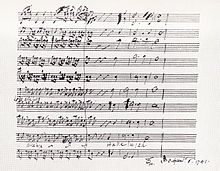Messiah
Messiah (HWV 56) adalah judul oratorio karya George Frideric Handel yang digubah pada tahun 1741.[1] Judul oratorio atau karya musik untuk orkestra, solo, dan paduan suara ini diambil dari konsep Yudaisme dan Kristen tentang Mesias. Dalam Kekristenan, Yesus disebut sebagai "Sang Mesias". Handel sendiri beragama Kristen, dan oratorio tersebut didasarkan pada kisah Alkitab mengenai karya Yesus di dunia sebagai Sang Mesias atau Juru Selamat menurut konsep Kristiani. Pertama kalinya ditampilkan di Dublin pada tanggal 13 April 1742 dan diberikan kesempatan premiere di London hampir setahun kemudian. Sesudah awalnya diterima dengan biasa oleh publik, oratorio ini menjadi terkenal, akhirnya menjadi salah satu karya koor yang paling terkenal dan paling sering ditampilkan dalam musik Barat.[n 1]
Meskipun Messiah lebih banyak menceritakan kisah tentang kebangkitan Yesus dari kematian, setelah kematian Handel, oratorio ini lebih sering ditampilkan pada masa-masa Adven (menjelang Natal).
Koor Hallelujah

Ini adalah bagian yang paling terkenal dari Messiah, yang mengakhiri bagian kedua dari tiga bagian Oratorio ini. Syairnya diambil dari tiga ayat Kitab Wahyu dari Perjanjian Baru, yaitu Wahyu 19:6, Wahyu 11:15, dan Wahyu 19:16.
|
|
Di berbagai tempat di dunia, penonton biasanya berdiri ketika bagian ini dinyanyikan. Konon menurut tradisi, Raja George II dari Inggris begitu tertegun oleh bagian ini sehingga ia bangkit berdiri. Akibatnya, seluruh hadirin yang menghadiri konser itupun berdiri juga, dan demikianlah tradisi itu dimulai.
Musik
Organisasi dan penomoran gerakan
Penomoran gerakan-gerakan di bawah ini sesuai dengan "Novello vocal score" (1959), yang disunting oleh Watkins Shaw, dengan mengambil penomoran sebelumnya yang dirancang oleh Ebenezer Prout. Edisi-edisi lain menghitung gerakan-gerakan agak berbeda; edisi Bärenreiter tahun 1965, contohnya, tidak memberi nomor semua recitative dan mengurut dari 1 sampai 47.[3] Pembagian ke dalam bagian dan adegan ("Scene") adalah berdasarkan buku-kata tahun 1743 yang disiapkan untuk penampilan perdana di London.[4] Judul adegan ("Scene") diberikan ketika Burrows menyarikan judul-judul adegan oleh Jennens.[5]
Scene 1: Isaiah's prophecy of salvation ("Nubuat Yesaya akan keselamatan")
Scene 2: The coming judgment ("Penghakiman yang datang")
Scene 3: The prophecy of Christ's birth
Scene 4: The annunciation to the shepherds
Scene 5: Christ's healing and redemption
|
Scene 1: Christ's Passion
Scene 2: Christ's Death and Resurrection
Scene 3: Christ's Ascension
Scene 4: Christ's reception in Heaven
Scene 5: The beginnings of Gospel preaching
Scene 6: The world's rejection of the Gospel
Scene 7: God's ultimate victory
|
Scene 1: The promise of eternal life
Scene 2: The Day of Judgment
Scene 3: The final conquest of sin
Scene 4: The acclamation of the Messiah
|
Catatan
Referensi
- ^ Juga diberi nomor katalog HG xlv (HG: Händel-Gesellschaft atau Karya Händel); dan HHA i/17 (HHA: Hallische Händel-Ausgabe).Templat:NewGrove2001
- ^ Myers, Paul (Transcription of broadcast) (December 1999). "Handel's Messiah". Minnesota Public Radio. Diakses tanggal 20 July 2011.
- ^ Burrows (1991), pp. ix and 86–100
- ^ Burrows (1991), pp. 83–84
- ^ Burrows (1991), pp. 55–57
Sources
- Armstrong, Karen (1996). A History of Jerusalem. London: Harper Collins. ISBN 0-00-255522-0.
- Beecham, Sir Thomas (1959). Messiah – An Essay. London: RCA. OCLC 29047071. CD 09026-61266-2
- Burrows, Donald (1991). Handel: Messiah. Cambridge (UK): Cambridge University Press. ISBN 0-521-37620-3.
- Burrows, Donald (1994). Handel. Oxford: Oxford University Press. ISBN 0-19-816470-X.
- Grout, Donald (1981). A History of Western Music (edisi ke-3rd). London: J M Dent & Sons. ISBN 0-460-04546-6. Parameter
|coauthor=yang tidak diketahui mengabaikan (|author=yang disarankan) (bantuan) - Hicks, Anthony (1991). Handel: Messiah (CD). The Decca Recording Company Ltd. OCLC 25340549. (Origins and the present performance, Edition de L'Oiseau-Lyre 430 488–2)
- Hogwood, Christopher (1991). Handel: Messiah (CD). The Decca Recording Company Ltd. (Notes on the music, Edition de L'Oiseau-Lyre 430 488–2)
- Laurence, Dan H. (ed.) (1981). Shaw's Music – The Complete Musical Criticism of Bernard Shaw, Volume 1 (1876–1890). London: The Bodley Head. ISBN 0-370-31270-8. Parameter
|coauthors=yang tidak diketahui mengabaikan (|author=yang disarankan) (bantuan)Pemeliharaan CS1: Teks tambahan: authors list (link) - Laurence, Dan H. (ed.) (1981). Shaw's Music – The Complete Musical Criticism of Bernard Shaw, Volume 2 (1890–1893). London: The Bodley Head. ISBN 0-370-31271-6. Parameter
|coauthors=yang tidak diketahui mengabaikan (|author=yang disarankan) (bantuan)Pemeliharaan CS1: Teks tambahan: authors list (link) - Luckett, Richard (1992). Handel's Messiah: A Celebration. London: Victor Gollancz. ISBN 0-575-05286-4.
- Robbins Landon, H. C. (1990). The Mozart compendium: a guide to Mozart's life and music. London: Thames & Hudson. ISBN 0-500-01481-7.
- Sackville-West, Edward (1956). The Record Guide. London: Collins. OCLC 500373060. Parameter
|coauthors=yang tidak diketahui mengabaikan (|author=yang disarankan) (bantuan) - Shaw, Watkins (1963). The story of Handel's "Messiah". London: Novello. OCLC 1357436.
- Steen, Michael (2009). The Lives and Times of the Great Composers. London: Icon Books. ISBN 978-1-84046-679-9.
- Steinberg, Michael (2005). Choral Masterworks: A Listener's Guide. New York: Oxford University Press. ISBN 0-19-512644-0.
- Taylor, Sedley (1906). The Indebtedness of Handel to Works by other Composers (PDF). Cambridge (UK): Cambridge University Press. OCLC 23474813.
- Young, Percy M. (1951). Messiah: A Study in Interpretation. London: Dennis Dobson Ltd. OCLC 643151100.
Pranala luar


- (Inggris) Messiah Diarsipkan 2010-02-05 di Wayback Machine. (dari gfhandel.org)
- For the full text, scriptural references and sound samples, see Messiah on Wikisource
- Messiah (Handel): Skor gratis di International Music Score Library Project
- Handel's Messiah at the Center for Computer Assisted Research in the Humanities
- Templat:NMA
- Hallelujah Chorus Flash Mob di YouTube
- High Definition Quality Recording Diarsipkan 2014-05-09 di Wayback Machine. OGG - AAC











